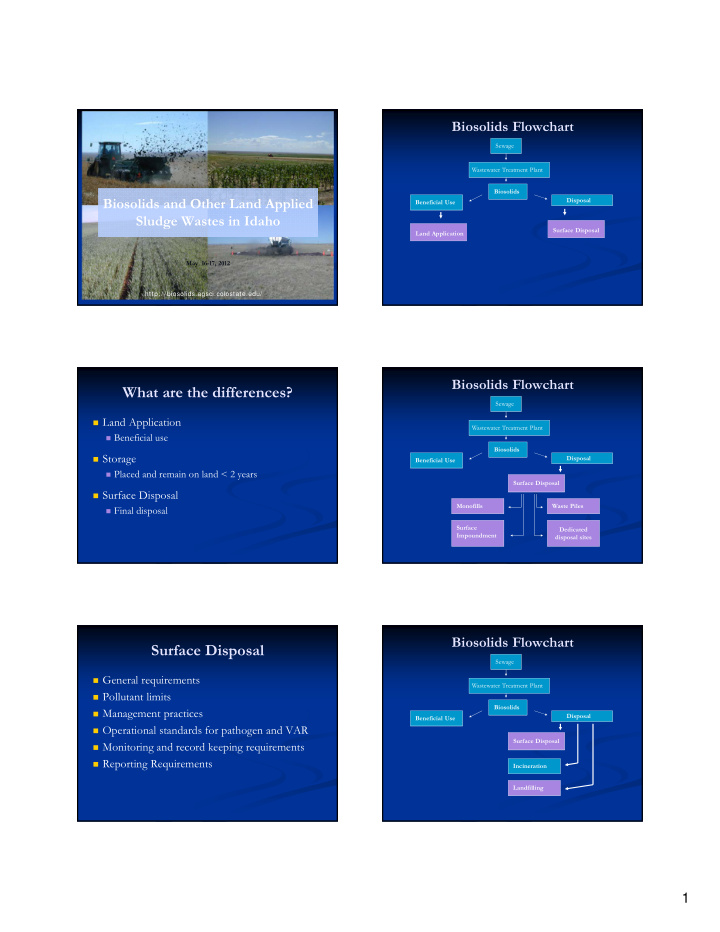



Biosolids Flowchart Sewage Wastewater Treatment Plant Biosolids Biosolids and Other Land Applied Disposal Beneficial Use Sludge Wastes in Idaho Surface Disposal Land Application May 16-17, 2012 http: / / biosolids.agsci.colostate.edu/ Biosolids Flowchart What are the differences? Sewage Land Application Wastewater Treatment Plant Beneficial use Biosolids Storage Disposal Beneficial Use Placed and remain on land < 2 years Surface Disposal Surface Disposal Monofills Waste Piles Final disposal Surface Dedicated Impoundment disposal sites Biosolids Flowchart Surface Disposal Sewage General requirements Wastewater Treatment Plant Pollutant limits Biosolids Management practices Disposal Beneficial Use Operational standards for pathogen and VAR Surface Disposal Monitoring and record keeping requirements Reporting Requirements Incineration Landfilling 1
Landfilling Landfill Operators Regulated by Part 258 of Landfill Rule Ask for documentation for Pass the paint-filter liquids test Hazardous waste characterization (dewatering biosolids to about 20 percent solids or more Paint filter test results will generally meet this goal) Cannot contain > 50 ppb of polychlorinated Procedures in operation plan for how they will biphenyls (PCBs) (40 CFR Part 761) manage biosolids Must not meet the definition of hazardous wastes Waste Acceptance Criteria Biosolids Flowchart Biosolids Incineration Sewage Involves the high temperature burning of biosolids in an enclosed devise Wastewater Treatment Plant Uses an auxiliary fuel supply Biosolids Gas, oil, wood chips, coal Disposal Beneficial Use The resultant ash is significantly lower in volume Surface Disposal than the feedstock (biosolids) Land filling Incineration Biosolids Incineration Biosolids Incineration Concentrates the trace metals Part 503 Incineration Requirements include: Ash Pollutant limits Non hazardous ash is not covered by Part 503 rule Limits for total hydrocarbons when it is used or disposed General requirements and management practices Ash is disposed according to solids waste disposal Monitoring, record keeping and reporting regulations in 40 CFR Part 258 requirements If ash is land applied then 40 CFR Part 257 applies 2
The Septic Tank connection… Other Sludge Wastes Septage and Pumpable wastes Biosolids Septage is classified according to the Domestic Septage environment in which it is generated. Domestic septage Industrial and Commercial Pumpable Wastes Industrial or commercial pumpable wastes Domestic Septage Mixed with Industrial or This is non-domestic waste Commercial Pumpable Wastes Domestic septage mixed with non-domestic pumpable wastes Biosolids Flowchart Domestic septage Residence Domestic septage is the liquid or solid removed Sewage from a septic tank, cesspool, portable toilet, type Septic Tank lll marine sanitation device, or a similar system Effluent that receives only domestic septage Domestic Wastewater Treatment Plant Septage Household Residence Sludge Non-commercial Non-industrial Septic Tank Biosolids Beneficial Use Disposal Domestic Septage Domestic Septage Domestic Septage Land Applied Domestic septage mixed with any sewage sludge Domestic septage land applied is considered sewage sludge. Regulated by 40 CFR 503 Regulated by 40 CFR 503 IDAPA 58.01.16 “Wastewater Home Home Rules” apply IDAPA 58.01.16 “Wastewater Needs a DEQ approved Plan Rules” apply Septic Tank Septic Tank Wastewater Treatment Plant Domestic Domestic Land Application Septage Septage Regulated by IDAPA 58.01.15 Sewage Sludge “Rules Governing Cleaning of Septic Tanks” 3
Industrial (or Commercial) Non-Domestic Pumpable Wastes Pumpable Wastes Land Applied Material pumped from septic tanks or other Industry or Not regulated by 40 CFR 503 Commercial devices used in the collection, pretreatment, or Business Regulated by IDAPA 58.01.16 Waste treatment of any water-carried waste from any “Wastewater Rules” process of industry, manufacturing, trade, or Needs a DEQ approved Plan business Septic Tank Examples: Grease Traps Industrial Car Wash Sumps Pumpable Waste Land Application or (non-domestic Industrial by products septage) http://www.boynewaste.ie/sludge.htm Land Applied Sludge Wastes Mixed Domestic and Non-Domestic need an approved Plan Biosolids Pumpable Wastes 40 CFR 503 IDAPA 58.01.16 “Wastewater Rules” Land Applied Domestic Septage Not regulated by 40 CFR 503 40 CFR 503 IDAPA 58.01.16 “Wastewater Rules” apply Regulated by IDAPA 58.01.16 IDAPA 58.01.15 “Rules Governing Cleaning of Septic Tanks” “Wastewater Rules” Industrial and Commercial Pumpable Wastes Needs a DEQ approved Plan No requirements under 40 CFR 503 Residence IDAPA 58.01.16 “Wastewater Rules” IDAPA 58.01.15 “Rules Governing Cleaning of Septic Tanks” Industrial Domestic Septage Mixed with Pumpable Wastes Land Application Pumpable Waste No requirements under 40 CFR 503 or (non-domestic IDAPA 58.01.16 “Wastewater Rules” apply septage) DEQ’s Website: DEQ Wastewater Program Staff Sludge & Biosolids Chas Ariss, P.E. Engineering Manager – Program Lead http://www.deq.idaho.gov/water-quality/wastewater/sludge-biosolids.aspx Tressa Nicholas, MSCE Reviews the Regulation of Biosolids in Idaho Wastewater Analyst, Biosolids, Training & Conference Has links to many sites including Coordinator A.J. Maupin, P.E. More links to EPA’s Documents Program Lead Engineer Biosolids Management Plan Olga Cuzmanov Permits, Compliance & Enforcement Analyst Guidance for Land Application of Municipal Lindsey Stanton Biosolids Administrative Assistant Development of a Biosolids Management Plan Checklist 4
Thank you! Workshop Webpage will have post workshop material Make sure you have signed in for CEU’s Thank you again, to Bob Brobst and Jim Ippolito!!! http://www.kingcounty.gov/environment/wastewater/Biosolids/DocumentsLinks.aspx Resources Northwest Biosolids Management Association Emerging Technologies for Biosolids Management EPA 832-R- 06-005 September 2006 http://www.epa.gov/owm/mtb/epa- biosolids.pdf A Plain English Guide to the EPA Part 503 Biosolids http://water.epa.gov/scitech/wastetech/biosolids/503pe_index. cfm 5
Recommend
More recommend